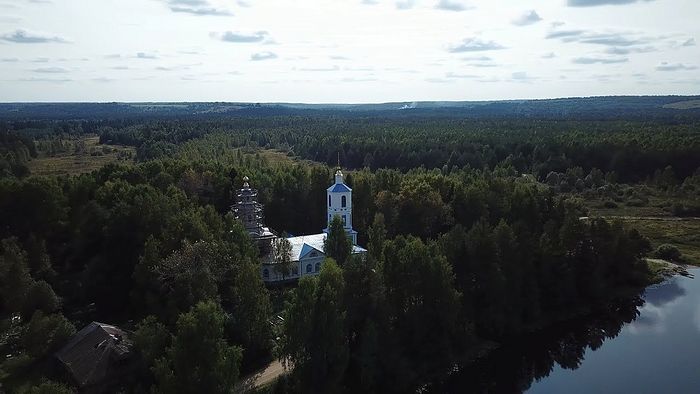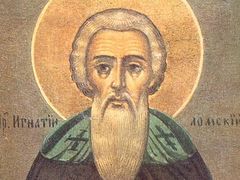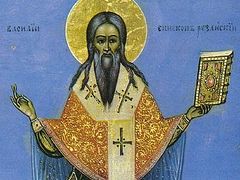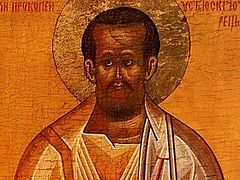For hundreds of years, Blessed Elder Leonid of Ust-Neduma was venerated as a local saint of the areas surrounding what is today the village of Ozer in the Kirov Province, where he had built a monastery and where his relics reposed. In February 2016, the Holy Synod of the Russian Orthodox Church approved his canonization for Church-wide veneration, and in February-March 2018, his relics were uncovered during a special excavation project at the Church of the Entrance of the Theotokos in Ozer. On June 18 of this year, His Holiness Patriarch Kirill of Moscow and All Russia blessed the veneration of the relics of St. Leonid. In honor of this great spiritual event, we present more extensive biographical information on St. Leonid than was previously available in English:
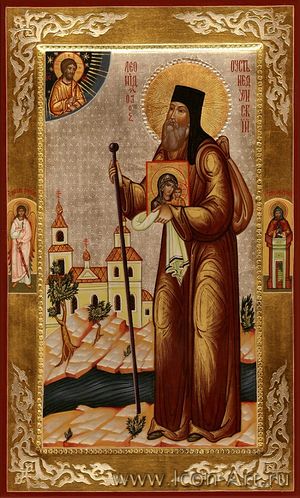 Photo: azbyka.ru Long was the life of St. Leonid, passing far beyond the usual limits of human life as indicated by the Psalmist (Ps. 89:10). But no news about the first half—fifty years—has come down to us, except that he was born in 1551 in the Novgorod Province, in the Blagoveschenie [Annunciation—Trans.] parish of the Poshekhonsk District (now the Yaroslavl Governorate) of Shekinsk Township to the peasants Philip and his wife Ekaterina. His pious parents, raising him in the fear of God and the principles of the Orthodox faith, tried to teach him to read books, which was a rarity at that time not only in the poor existence of Poshekhonsk peasants, but also in the upper classes. About what prompted these peasant parents to teach their son to read, whether he was married and how he lived: in contentment or poverty—absolutely nothing is known. It is only known that these fifty years, spent by Leonid in farming, did not pass without an effect on the rest of his life: They shaped him into a man with a faithful view of things, expanded his horizons, and strengthened his will.
Photo: azbyka.ru Long was the life of St. Leonid, passing far beyond the usual limits of human life as indicated by the Psalmist (Ps. 89:10). But no news about the first half—fifty years—has come down to us, except that he was born in 1551 in the Novgorod Province, in the Blagoveschenie [Annunciation—Trans.] parish of the Poshekhonsk District (now the Yaroslavl Governorate) of Shekinsk Township to the peasants Philip and his wife Ekaterina. His pious parents, raising him in the fear of God and the principles of the Orthodox faith, tried to teach him to read books, which was a rarity at that time not only in the poor existence of Poshekhonsk peasants, but also in the upper classes. About what prompted these peasant parents to teach their son to read, whether he was married and how he lived: in contentment or poverty—absolutely nothing is known. It is only known that these fifty years, spent by Leonid in farming, did not pass without an effect on the rest of his life: They shaped him into a man with a faithful view of things, expanded his horizons, and strengthened his will.
His nearness to nature and farm work, which place a man in full dependence upon it and encourage a farmer to hope for the precious fruit (Jas. 5:7) of his labor only from the bounty of the Heavenly Father, taught him patience and preserved within him a childlike simplicity of heart, making him worthy of spiritual revelations. It’s not known whether Leonid ever thought about leaving his farming and dedicating himself to the monastic life, but when in 7111 (1603)1 he saw the Mother of God in a dream one night, commanding him to go to the Dvina River to the Morzhevsk-St. Nicholas Hermitage, to take her Hodigitria icon from there and transfer it to the Ustiug limits in the Usolsky District to the River Luza to Turina Gora, and, having built a church in its honor, to remain there until death. Although he considered this vision an ordinary dream, not accepting it as revelation, considering himself unworthy, he quickly left his work and, despite his advanced age, headed for Kozhe Lake Monastery, at that time located on Lopsky Island, and there received the monastic tonsure.
In order to leave all worldly habits from the first moment, to experience all sorrows and hardships and to see all the difficulty and constraint of the monastic path in practice, he didn’t need to seek any other place but this reemerging monastery, located in a poor and severe country, surrounded by the waters of the deserted lake and remote from any human dwellings. Here, even in the best of times, already under the third abbot, the famous Nikon (later Patriarch), they sometimes lacked bread, and the brothers were forced to eat tree bark. At that time, when Leonid arrived, the forest on the island had just been cut down, the tiny and poor Holy Theophany Church had been built, and the blessed laborer Elder Serapion had built a common building for the brothers. Through the forest thicket and brushwood, through the moss and mire, he went to Onega for some grain to save the companions gathered to him from starvation.
In the same year, another brother came to the Kozhe Lake Monastery from Moscow—Nikodim, subsequently the Kozheozersk hermit. Leonid lived in the community with him for a year under the guidance of the experienced Elder Serapion, trying to emulate his mentor in everything. Of course, he would have never parted with him and left the desert habitation if his previous dream had not repeated itself, commanding him to go to the Morzhevsk hermitage and take the Hodigitria icon to Luza. Then, in bewilderment and fear, telling no one about his vision, he left Kozhe Lake Monastery and, walking along the Onega River, he reached the sea and left for Solovki to venerate the relics of Sts. Zosima and Savvaty.
Graciously received by the abbot, he lived there for three years like a novice, laboring in the bakery. Constantly engaged in his obedience, the most difficult in populous monasteries, St. Leonid had only just begun to settle down and forget about his twice-seen dream when he saw it a third time, so vividly and clearly as if it were not in a dream but in waking. The Most Holy Virgin appeared to him in the same form and ordered him to immediately go to the Morzhevsk hermitage and transfer her icon to Luza. Then the elder understood that it was no ordinary dream and became afraid from having not believed it and having not fulfilled the order of the Mother of God for so long. With bitter tears, he told Abbot Anthony about his thrice-seen dream and asked a blessing to leave Solovki. The abbot advised him not to resist the will of God any longer, so as not to incur Heavenly wrath upon himself, and prayerfully released him from the monastery, Thus St. Leonid immediately headed for the Morzhevsk hermitage. (In 1682, the Morhzegorsk-St. Nicholas Monastery, close to Kholmogory, was attached to the Kholmogory bishop’s home.)
Having arrived there, Leonid did not venture, however, to tell the abbot about the reason for his arrival, thinking that they wouldn’t believe him, an unknown stranger, and he spent another entire year in the Morzhevsk hermitage in great labors, constantly thinking about the dreams he had seen, dreading and trembling because he had still not fulfilled the order. But the good Mother of the good God was not angered about what was done out of ignorance and perplexity. She mercifully condescended and looked upon the prayers and tears of the elder, in whom she saw her future fervent servant, and appeared to him a fourth time, commanding him to transfer her icon to the place she appointed. With great awe and fear, the elder dared to ask: “Show me, My Lady, where is the image of your most pure countenance, and, embracing it with my sinful hands, I will go to that place that you have appointed.” The Most Holy Virgin so clearly showed him the icon and place where it stood in the church, as though it were not in a dream but he was seeing it with his bodily eyes.
Rousing himself, the elder started trembling and in fear exclaimed: “Most Holy Theotokos, help me, a sinner,” and “weeping bitterly for a long hour and barely having come to himself after the terrible vision, and having thanked God and His Most Pure Mother, he went to the Church of St. Nicholas the Wonderworker during Matins and informed the abbot and brethren about the Most Pure Theotokos’ multiple appearances to him, how she appeared to him and showed him her icon. The pious abbot (Cornelius Kochergin, 1599-1623), and the brethren, in fear over what they had heard, sang a moleben after the Divine Liturgy. The abbot took up the honorable Hodigitria Icon of the Most-Pure Theotokos with the Pre-Eternal Infant and gave it to Elder Leonid, and falling down before the icon he kissed it, and they prayed with tears. All the brothers and the people also venerated it and accompanied the icon of the Most Holy Theotokos to the ringing of bells.” (From the manuscript of the Ust-Neduma Church.)
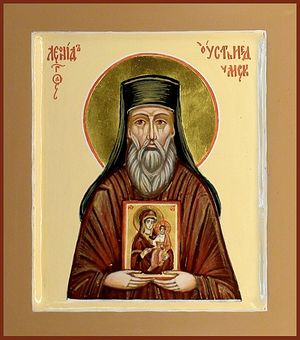 Photo: azbyka.ru Having received the holy icon, and guided by the prayers and good wishes of all the brethren, Elder Leonid joyously left for the place appointed him, although he didn’t know where it was and had never been to that land. Reaching the Luza River, he stopped at Turina Gora, at the mouth of the River Yakushitsa, flowing into the Luza eighty versts2 from Ustiug. There was a Church of the Resurrection of Christ there. The traveler liked the place, so, having made a small shack out of tree branches and brushwood, he settled into it and lived there for a while, spending his days and nights in fasting and prayer and constantly thinking about how he would build a church and monastic habitation, as he was told in his vision. But the place was cramped, there was little dry land, and all around was swamp and bog. Moreover, when the locals who valued the land found out about the elder’s intentions, they not only did not allow him to start building, but even drove him out of his shack.
Photo: azbyka.ru Having received the holy icon, and guided by the prayers and good wishes of all the brethren, Elder Leonid joyously left for the place appointed him, although he didn’t know where it was and had never been to that land. Reaching the Luza River, he stopped at Turina Gora, at the mouth of the River Yakushitsa, flowing into the Luza eighty versts2 from Ustiug. There was a Church of the Resurrection of Christ there. The traveler liked the place, so, having made a small shack out of tree branches and brushwood, he settled into it and lived there for a while, spending his days and nights in fasting and prayer and constantly thinking about how he would build a church and monastic habitation, as he was told in his vision. But the place was cramped, there was little dry land, and all around was swamp and bog. Moreover, when the locals who valued the land found out about the elder’s intentions, they not only did not allow him to start building, but even drove him out of his shack.
Greatly saddened, and with tears and the holy icon in his hands, Leonid left this beloved place and, not knowing where to go, went through the forest along the banks of the River Luza. Going two miles, he met a peasant named Nikita Nazarov, one of the most affluent in the area. The pious farmer was surprised to meet an elder-monk in such a place where there had never even been a path, and, seeing his tears, started asking him who he was, where he was from, where he was going, and what he was crying about. Dropping to Nikita’s feet and sobbing bitterly, Leonid told him everything in detail, showed him the icon of the Mother of God, and asked him to show him a place where he could settle in and build a church for the holy icon.
The elder’s story and tears touched Nikita, and praying before the icon with reverence, he offered him the place where they met. Leonid overwhelmingly rejoiced at the offer, and thanking God and his good-natured giver, he placed the holy icon under a tree and began to cut down trees to build himself a cell. Nikita was not satisfied with just giving the elder a place, but he also helped him build a cell, would go to him for discourse and prayer before the icon of the Mother of God, and would send him food. When the surrounding people learned about it, they little-by-little started going to pray before the holy icon that was brought from a distant monastery and chose itself a place in this country. In this they saw the Mother of God’s favor towards them, and their zeal for the icon began to grow more and more. The locals soon built a chapel for the icon, and getting to know the hermit better and seeing in him a true ascetic, they started sending him everything necessary for life, entreating his prayers for themselves.
Seeing such zeal for the icon of the Mother of God in the people, Blessed Leonid did not postpone his intentions to build a church of God, but headed for Rostov to the metropolitan to ask his blessing for it. Metropolitan Philaret not only blessed him to build a church, but also gave him holy antimensions3 for its consecration. He also granted the elder the dignity of the priesthood and instructed him to be the head of the monastic abode he was building. Returning to Luza, Blessed Leonid gathered the local residents in a council and asked them to help him in building the church, to which they willingly agreed. Thus, near Leonid’s secluded cell, on the place of the chapel in which the icon of the Mother of God was kept, the Church of Her Entrance into the Temple was soon built. The holy icon was transferred there on February 17, 7116 (1608) upon consecration of the church.
From that time, healings and miracles flowed from the icon as from an inexhaustible spring, which yet further glorified the monastery being built and filled it with brethren. Elder Leonid received those coming to him with fatherly love, serving as a living example of the strict fulfillment of monastic obligations for them and showing them an example of amazing diligence. Since the place where the church was located was low and damp, surrounded by swamps, it was almost completely unsuitable for habitation. The nearly sixty-year-old elder decided to undertake draining it, which was hardly within the strength of several young and strong workers.
“And starting to dig the swampy forest, impenetrable up to Black Lake, laboring much and being afflicted by the heat of the sun and from gadflies and mosquitoes, he never once laid aside his prayer rule. The devil, hating good deeds and wanting to frighten him and drive him away from his labors, inflicted him in the following manner: While he was digging, a snake suddenly came up and bit him in the left foot. The elder quickly jumped out of the pit and thought of running, but his foot was injured and he began to tearfully pray to the Lord God and the Most Pure Theotokos. Having slept little, he awoke and heard a voice: ‘Grieve not, Elder, and think not of fleeing, but return again to your work, hoping in the mercy of God. The Most Holy Theotokos helps you and no harm will befall you from the snake.’ The elder again began to labor and called the spring the Neduma River. That type of snake was never seen in the swamp before then and never again to this day. To dig this impenetrable forest swamp from the Luza River to Black Lake was 900 sazhens,4 and from Black Lake there were forty sazhens to dig up to the Holy Lake, and from Holy Lake until Black River there were 800 sazhens, and the Black River flows from the forest’s distant swamps. So he turned the Black River towards Holy Lake and to the Black and Luza Rivers by the trench he dug, and Elder Leonid built a mill wheel on this river.” (From the manuscript of the Ust-Neduma Church.)
The region where Blessed Leonid dwelt was remote and desolate. After a long time it started being called “Luza Permtse,” that is, the land of the wild Permians [natives of Perm—Trans.]. From this it is clear how important it was to have a hermitage for this wild region in Church and civil relations—not to mention the beneficial influence that the elder had on the surrounding residents as a teacher of the faith and piety by his discourses and instructions, and especially by his holy and ascetic life. His indefatigable hard work, the strict order in the living quarters that had been built, and his great care and initiative in all things could be very useful and serve as an example for emulation to the semi-savage residents of Perm. Therefore, St. Leonid is rightly revered as the enlightener of this remote country.
The innumerable miracles and healings coming from the Hodigitria icon he brought was a consolation for the saint and served as a clear sign of the mercy and favor of the Mother of God towards him. People afflicted with various ailments would come to his desert abode from afar to venerate the holy icon of the Mother of God and would return home healthy. Others, who had not yet been to the monastery, only having made a promise to go, would receive healing and then go to the monastery to fulfill their promise already completely healthy. It sometimes happened that when those who had promised to go to the monastery to venerate the holy icon forgot about it or postponed the fulfillment of their promise for this or that matter for a long time, the blessed elder would miraculously appear in a vision and remind them of the promise they had made.
Thus, in 7118 (1610), a certain Bad Konkov, who had arrived to the Ust-Neduma hermitage on February 25, declared to the brothers that he had been severely tormented by a demon for a long time. His face and entire appearance changed such that it was frightening to look at him. Once, when he was lying alone in his room, exhausted from a strong demonic attack, an unknown elder appeared to him and, approaching his bed, began to reproach him because he, Bad, did not fulfill his promise to go to the hermitage to venerate the wonderworking icon of the Mother of God. “Thou hast not found deliverance from thy suffering, for he who does not fulfill his promise and delays to go will in no way find deliverance from his infirmity,” said the one who had appeared to him and then became invisible. Then the sick man remembered his promise and hurried to go to the monastery, and when a moleben was sung before the wonderworking icon of the Mother of God for him, “he began to be of sound mind and his face became light, and there was no enemy oppression against him or heaviness.” In the face of Elder Leonid, who served a moleben to the Mother of God for him, he was surprised to recognize the unknown elder who had appeared to him during his illness.
How many struggles with inhospitable nature St. Leonid endured, how many labors he undertook in building the monastery! But all these podvigs seemed to him small and insufficient, and so wishing to reach the highest perfection, he had a custom of often leaving his monastery for a deserted and impassable forest place near Black Lake. There at one spot he erected a cross and spent days and nights in prayer, “suffering great disturbance from forest gnats, gadflies, and mosquitoes.” Many passing by and seeing him sitting at the cross in the forest and covered with forest gnats were amazed by his voluntary suffering; others mocked him and said his forbearance was in vain. The elder told them: “Here at the cross there will be a monastery with a gathering of monks, there will be churches and bells, there will be many people and arable land, and I will die on this place.” When the brothers, pitying him, would come to call him to the monastery, sometimes he would return with them, and sometimes, despite all their requests and pleas, he remained there to continue his podvigs.
The saint’s prophecy was fulfilled during his lifetime. The canal, made by St. Leonid’s incredible labors and named Neduma River by him, considerably drained the swamp; but in the spring the Luza often overflowed the banks flooding and inundated the monastery, which stood on a low spot. In other years, the water would stand for several days not only in the cells but even in the church; it poured into the barns and storehouses and ruined the monastery’s supplies. There was no way to avoid this nearly annual calamity other than to move the monastery to another, more elevated place. St. Leonid was quite grieved about it and although he was already nearly a hundred years old, and so weak and infirm that he had handed the administration of the monastery over to abbot Arseny while he himself spent a large part of his time in solitude and silence and preparation for death, he did not want to die until the monastery was moved to his most beloved place, to the high point of Black Lake, and until the brothers could be settled there.
Therefore, having invited Gregory, the son of Nikita Nazarov, and other influential people from among the surrounding residents to the monastery, he announced to them his desire to transfer the monastery to the cape of Black Lake and asked for their help in this matter. When the abbot, the brothers, and all the invited peasants unanimously approved of his intention and expressed a willingness to help him, the elder asked them to invite people and on the appointed day, celebrating a moleben in the church, he lifted up the wonderworking icon of the Mother of God and, accompanied by all the brothers and a multitude of people, he moved it to the cape. Having placed the icon by the cross, he started felling trees to build the church.
The brethren and all the invited peasants followed the elder’s example and soon felled enough trees for the church and other monastery buildings. The next year the church was founded with the blessing of Metropolitan Varlaam of Rosotv in honor of the Entrance of the Theotokos Into the Temple, with a side altar to the Great Martyr Paraskeva. When it was built, St. Leonid invited Archimandrite Arseny of the Ustiug Archangel Monastery for its consecration, for greater solemnity. With a cross procession, with burning candles, with the singing of laudatory hymns, and with a multitudinous gathering of people, they transferred the wonderworking icon of the Mother of God form the former monastery to the newly-built church and consecrated it on May 23, 7160 (1652). It was a joyful day in the life of the holy laborer Leonid and his last act for the benefit of the habitation he built.
With the transfer of the monastery to a new spot, the blessed elder spent the majority of his time in secluded prayer and silence, leaving his cell only for church, completely removing himself from the administration of the monastery. Like a lamp, he quietly burned to the end, and after a little over two years he reposed from his labors, and settled into the eternal abodes to behold eternally Her to whose holy and wonderworking icon he had dedicated himself for so long. His blessed end occurred on July 17, 1654. St. Leonid’s relics repose beneath the earth in the former monastic, now parish church.5 His heavy and cruel hair-shirt is preserved there to this day, and as during the blessed elder’s lifetime, so today there is a large confluence of pilgrims annually on the ninth Friday after Pascha.
Troparion, tone 1
Aflame from thy youth with divine love and the spiritual life, O saint, and having hated all that is cherished in the world, thou didst love Christ alone with all thy soul, O father. Having taken the easy yoke upon they shoulders, thou wast guided by Divine Providence and a divine vision of the Most Pure Theotokos and reached the wilderness place where thou didst toil ascetically for many years in great labors and tears, exhausting thy flesh through all manner of sufferings. Whence didst God Who sawest they labors multiply thy children in the wilderness. But having great boldness before God, pray for us thy servants, O holy Father Leonid, that He might deliver us from the attacks of the enemy, and save our souls.

